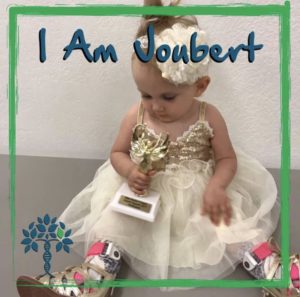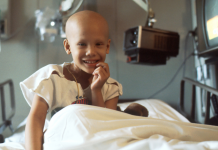Although she is little, Hensley is fierce.
Her mother, Meghann, delivered her naturally at 38 weeks. Hensley was perfect, with the brightest blue eyes. At first, nursing was hard because Hensley shook her head back and fourth all the time and couldn’t latch correctly.
As a pediatric certified chiropractor, I am trained to examine children in a unique way. I noticed that Hensley had mild torticollis and additional tightness in her jaw that can make nursing difficult. In addition, she was weaker (also known as hypotonic) in her abdomen and neck, with rigid hands. These findings weren’t necessarily alarming right away, but I knew we had to keep an eye on them. Hensley was able to nurse correctly after an adjustment, but she was not holding her adjustment as long — or becoming as strong — as other babies her age.
The Diagnosis
At seven months old, her eyes were still not tracking and she was becoming noticeably further behind the average. Her pediatrician ordered an MRI. Within minutes of getting home from Cook Children’s Pediatrics, Meghann received a phone call. The pediatrician asked if Meghann was sitting down. They had found a “molar tooth” deformity, the pediatrician said, and Hensley has Joubert syndrome — a rare genetic disorder diagnosed in just a few children here in North Texas. She spelled it all out for Meghann, saying that she was sorry, but a part of Hensley’s cerebellum hadn’t developed. The news was devastating.
Meghann identifies one of the hardest things about Hensley’s condition: She looks normal. Many people don’t understand why Hensley isn’t walking or smiling at them, because she looks like a typical two year old. Having a child with a genetic abnormality (or other birth defects) is a huge weight for mothers to bear, especially when the worst-case scenario pops up after looking up symptoms on Google.
 The Cause
The Cause
Many of us with genetic disorders — or with a child who has such a disorder — wonder if we did something to cause it. The unfortunate truth is that it’s all chance. Most researchers agree that genetic instructions a child inherits from his or her parents set a sort of railroad track for development. The genetic instructions are not flawless, and development can go off course at times. The child’s environment can influence how these paths are expressed or even silenced.
Things look differently for a child with a genetic abnormality. This can happen when a sperm or egg is formed and the number of chromosomes divide unbalanced. If one of these abnormal cells unites with a normal cell from the other parent, the zygote (fertilized ovum) will possess an uneven number of chromosomes. Researchers suggest that most of these unions will never fully develop and will result in miscarriage. In the babies that are able to make it to birth, the result is some type of syndrome with its own set of distinguishing characteristics.
The Path Forward
What is some of the best advice that moms like Meghann can give to families starting on this same path?
- Be an informed and researched parent. Search for the foundation dedicated to the disorder.
- Follow those foundations on social media to stay up-to-date with new testing and research. Look for a Facebook group to connect with fellow parents (check out FWMB’s Moms of Special Needs Kids Tarrant County Area Group).
- Don’t be afraid to try alternatives such as chiropractic, craniosacral, and equine therapies. You might have to turn to private therapy instead of just state-funded options.
- Seek a second opinion or request a different therapist if you don’t feel that you are being helped to guide your child on the right path.
- Make sure to keep a three-ring binder of all your child’s documents at the ready for any new doctor.
- Celebrate everything! Raising her head, reaching for a toy with one hand, making eye contact, and smiling are all huge victories that took her a lot of effort. Each should be celebrated.

Families that are not personally walking this journey should remember to be patient with those that are. Don’t take it personally or get upset with your friend when she seems preoccupied. The saying “you would do anything for your child” is exactly what this mama is doing. Continue to reach out; it is more appreciated than you know.
Although there is no cure for a genetic abnormality, many therapies are available to help children progress to their fullest potential. Hensley is currently in weekly speech, physical, occupational, and chiropractic therapies with monthly visits from a vision teacher and a craniosacral therapist. She is now two and a half years old and just took her first steps on December 29, 2017! She fought hard for every advance she achieved. She loves life, babies, and animals, and her sweet personality is flourishing. She has taught me to press on and work hard every day.
 Dr. Michelle Parker is a wife, mom to two rambunctious boys, and a doctor of chiropractic in Aledo, Texas. She has extensive post-graduate training in child and pregnancy health and is the only pediatric certified chiropractor in Parker County. Her focus is to inspire health, build a local motherhood community, and provide breastfeeding tools. She is also a holistic child’s health expert. The Chiropractic Place for Mommy and Me is located just 15 minutes west of downtown Fort Worth and integrates chiropractic, myofascial release, and craniosacral therapies to provide superior results.
Dr. Michelle Parker is a wife, mom to two rambunctious boys, and a doctor of chiropractic in Aledo, Texas. She has extensive post-graduate training in child and pregnancy health and is the only pediatric certified chiropractor in Parker County. Her focus is to inspire health, build a local motherhood community, and provide breastfeeding tools. She is also a holistic child’s health expert. The Chiropractic Place for Mommy and Me is located just 15 minutes west of downtown Fort Worth and integrates chiropractic, myofascial release, and craniosacral therapies to provide superior results.













